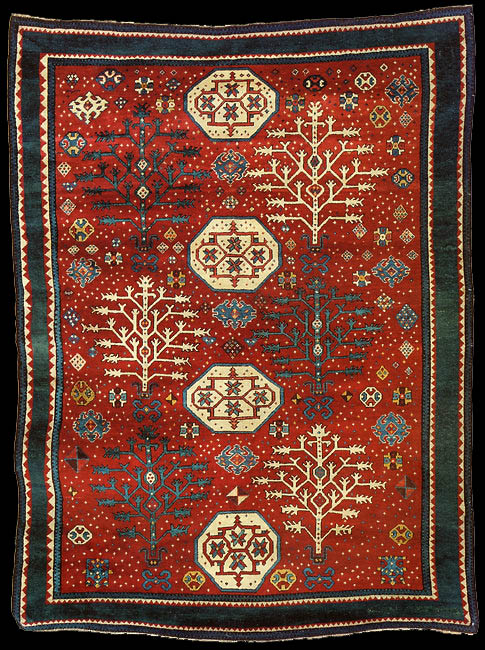|
Lot 278: Tree Kazak Rug
Price Realized £44,650 ($64,609)
Sale Information
Christie's
Sale 6499
ORIENTAL RUGS & CARPETS
18 October 2001
London, King Street
A TREE KAZAK RUG
South Caucasus, circa 1820
The brick-red field scattered with minor stylised flowerheads, hooked panels
and minute cross-motifs around a column of ivory octagonal panels containing
radiating flowerheads and minute cross-motifs flanked on either side by
ivory and blue angular trees in a shaded blue border between zigzag and
linked vine stripes
6ft.6in. x 5ft. (198cm. x 152cm.)
Literature
Eiland, Murray L. Jr.: Oriental Rugs from Pacific Collections, San
Francisco, 1990, no.212, p.205.
Lot Notes
The "tree Kazak" rug is one whose iconography stands out clearly from the
other well-known Kazak types. Unlike the medallions of various shapes and
symbolism, these rugs are covered with immediately recognisable plants
forms. The motif seems to have been adopted into a number of other Kazak
rugs which have different proportions and in particular different borders,
but there is a core group, of which the present rug is probably the
archetype, which share various features. They tend to have two columns of
(usually three) trees flanking central octagonal medallions. These designs
are always on a red ground within a relatively narrow green border flanked
by zigzag motifs. Two of this type are dated, the earliest to 1273 (1856-7
AD) (Christie's East, New York, 12 May 1985, lot 12; the other in a private
American Collection to 1290 (1873-4 AD) (Hali 66, December 1992, p.118).
In contrast to a number of the later examples, this rug has superbly
lustrous wool and fully saturated colour; this is such that the rug appears
to glow. Another feature that makes it stand out is the absence of any
motifs in the border. This feature is matched by only one other example in
the group, a longer rug which in its size shows clearly the origin of the
design in the 18th century corridor carpets with trees woven in North West
Persia (see for example Oriental Rugs from Atlantic Collections,
Philadelphia, 1996, no.63, p.63). That rug, formerly in the McMullan
Collection, is now in the Metropolitan Museum of Art (McMullan, Joseph V.:
Islamic Carpets, New York, 1972, no.47, pp.192-3). In her discussions on
garden carpets Christine Klose dates the McMullan example to the eighteenth
century (Hali, vol.1, no.2, p.120, pl.9 - incorrectly captioned).
 |

